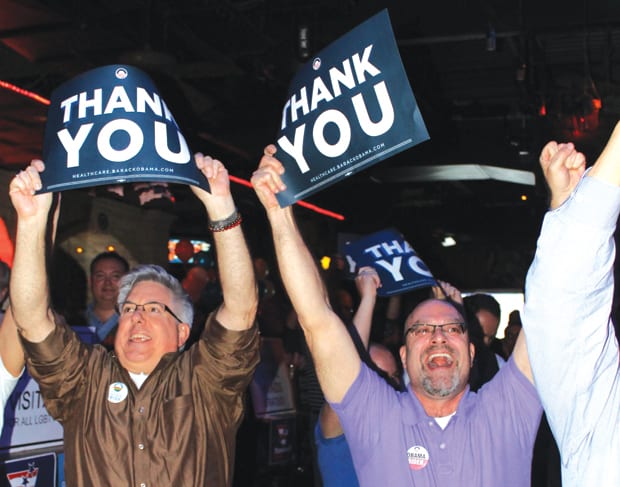
FOUR MORE CHEERS | Stonewall Democrats members Jay Narey, left, and Charles Griffin celebrate at the Round-Up Saloon Nov. 6 after the race was called in favor of Barack Obama. (David Taffet/Dallas Voice)
1.
During his first three years in office, President Barack Obama had already done more to advance LGBT equality than any president in history.
He’d successfully championed federal hate crimes legislation and the repeal of “don’t ask, don’t tell,” stopped defending the anti-gay Defense of Marriage Act in court and made hundreds of LGBT appointments, among other things.
But as 2012 began, and with the November election looming against the backdrop of an all-too-sluggish economic recovery, LGBT advocates made it clear Obama would need to do even more to shore up one of his key constituencies.
Specifically, they called for the president to complete his so-called evolution on marriage equality and sign an executive order banning anti-LGBT employment discrimination by federal contractors.
However, after a high-level meeting with LGBT leaders at the White House in April, it became clear the latter wasn’t going to happen anytime soon.
As with DADT, Obama wanted to hold out for a permanent legislative solution in the form of the Employment Non-Discrimination Act.
The news led to reports of some major LGBT donors withholding contributions to Obama’s re-election campaign, but their concerns would be put firmly to rest a month later when Obama made a historic announcement. On May 9, in an interview with ABC News’ Robin Roberts, the president finally came out for marriage equality.
“At a certain point, I’ve just concluded that for me personally it is important for me to go ahead and affirm that I think same-sex couples should be able to get married,” Obama said. “I had hesitated on gay marriage in part because I thought that civil unions would be sufficient.”
The LGBT community rejoiced — and subsequently rewarded Obama with large infusions of campaign cash. (Even before his announcement, a Washington Post analysis found that one in six Obama “bundlers” who raised more than $500,000 were gay.)
There was some backlash against Obama’s support for marriage equality, to be sure, perhaps the most alarming of which was within the black church, but days later the NAACP would seemingly quell the dissent by coming out for marriage equality itself. Even the Texas Democratic Party added marriage equality to its platform on the president’s coattails, and the National Democratic Party would later do the same.
Above all, though, Obama’s announcement drew the starkest of contrasts with his opponent, Republican Mitt Romney, who’d signed a pledge from the National Organization for Marriage saying he’d seek to enshrine discrimination into the U.S. Constitution by backing a federal marriage amendment.
Perhaps because the contrast was so stark — but more likely because they were overshadowed by the economy — LGBT issues were largely absent from the latter days of the campaign, and were not discussed at all during the debates.
But come Election Day, the LGBT vote would prove to be a major, if not decisive, factor.
Exit polls showed that with 5 percent of voters identifying as gay, 76 percent of them supported Obama and 22 percent supported Romney. Among straight people, each candidate received 49 percent of the vote, and in swing states like Ohio and Florida, Romney was believed to have won the straight vote.
As the year wound down, LGBT advocates made a new list of requests for the president. It contained things like the nondiscrimination executive order, legislative repeal of DOMA, an LGBT cabinet member and briefs to the U.S. Supreme Court as it prepares to hear two cases involving marriage equality.
Judging from Obama’s record — though it may not be precisely where, when or how we want — he’ll continue to deliver.
This article appeared in the Dallas Voice print edition December 28, 2012.


